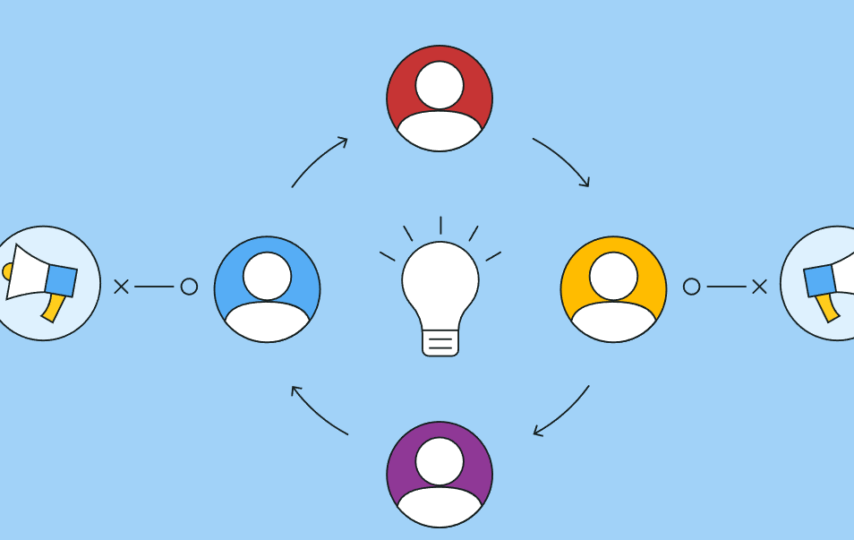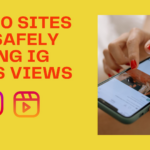In the changing world of marketing, one thing remains constant; change. Throughout the years we’ve witnessed a transformation, in how brands communicate with their target audiences. The days of broadcasting a message to the masses and hoping it sticks are long gone. Today’s landscape is vastly different requiring a targeted and sophisticated approach.
The Evolution of Marketing: From Generic to Industry-Centric Campaigns
In the days of marketing generic campaigns were the norm. These campaigns aimed to appeal to an audience as much as possible through broad strokes. The idea was simple; cast a net. Hope to catch as many people as possible. However, as markets became saturated and consumers became more discerning it became clear that this approach had its limitations. Not all messages resonated with all audiences.
This led to the rise of industry-focused campaigns. Brands began to recognize the power of tailoring their messages to industries and niches. By harnessing industry knowledge they could create campaigns that directly addressed the needs, desires, and pain points of specific segments within their target audience. This shift went beyond personalization; it was, about precision.
Understanding the intricacies of an industry, including its trends, challenges and opportunities is crucial. It allows us to create a message that deeply resonates with our target audience.
The Significance of Resonating with the Right Audience
In today’s market, it’s not just beneficial but essential to resonate with the right audience. Consumers are bombarded with messages every day making it challenging to stand out. When a campaign truly resonates it not grabs attention but also leaves a lasting impact by being shared and acted upon.
Resonance involves more, than knowing your audience’s demographics; it requires delving into their psychographics. This means understanding their motivations, aspirations, fears, and desires on a level. Crafting a message that not only informs but inspires and evokes emotion is the key.
The shift from campaigns to industry ones reflects a broader marketing trend; establishing meaningful connections with audiences. As marketers our aim goes beyond visibility or audibility; we strive to be understood and valued. Resonating with the audience is paramount, in this age of marketing.
The Art of Personalized Marketing
It’s all, about getting your message sharing your vision, and motivating people to take action. However, like how every person has a unique story, each segment of the audience has its own specific preferences, needs, and aspirations. Recognizing and catering to these differences is where the true art of marketing comes into play.
The Pitfalls of One-Size-Fits-All Campaigns
In the days of advertising and marketing, it was common to adopt a one-size-fits-all approach. Campaigns were created with an audience in mind resulting in messages that aimed to appeal to everyone but often failed to resonate with anyone, in particular. This approach, while cost-effective and straightforward, had several inherent pitfalls:
Lack of Relevance. Generic campaigns often miss the mark in addressing the specific needs or concerns of individual audience segments. A message that’s too broad can come off as impersonal and detached.
Low Engagement. Without a personal touch or direct relevance, these campaigns struggled to engage audiences deeply. Engagement isn’t just about catching the eye; it’s about capturing the heart and mind.
Wasted Resources. Broad campaigns, while reaching a large audience, often fail to convert a significant portion of them. This meant wasted resources on audiences that were never going to be interested in the first place.
The Transformative Power of Industry-Specific Strategies
As the limitations of generic campaigns became evident, marketers began to explore the potential of industry-specific strategies. These strategies, rooted in deep industry knowledge and insights, offered a fresh approach:
Deep Resonance. By tailoring messages to specific industries, brands could address the unique challenges, aspirations, and pain points of their audience. This led to campaigns that resonated on a much deeper level.
Higher ROI. Personalized campaigns, by virtue of their relevance, often resulted in higher engagement, better conversion rates, and, ultimately, a better return on investment.
Building Trust. Industry-specific campaigns showcased a brand’s expertise and understanding of its audience. This not only positioned the brand as an industry leader but also built trust among its audience.
Fostering Loyalty. When customers feel understood and valued, they are more likely to remain loyal to a brand. By addressing individual needs and preferences, personalized marketing fosters a deeper sense of loyalty.
The shift towards personalized, industry-specific marketing is a testament to the evolving dynamics of the consumer-brand relationship. In a world where consumers are more informed and discerning than ever, the brands that truly understand them, speak their language, and address their specific needs are the ones that stand out and thrive.
Digital Evolution: Adapting to Niche Audiences
The digital age has revolutionized the way we communicate, shop, work, and entertain ourselves. With this transformation, the marketing landscape has also undergone a seismic shift. While the digital realm offers unprecedented opportunities to reach and engage with audiences, it also presents unique challenges, especially when targeting niche segments.
The Unique Challenges of Marketing in the Digital Age
Information Overload: The digital space is saturated with content. Every day, consumers are bombarded with a plethora of messages, making it challenging for brands to stand out and capture attention.
Evolving Algorithms: Platforms like Google, Facebook, and Instagram constantly update their algorithms, affecting content visibility and reach. Brands must stay updated and adapt their strategies accordingly.
Diverse Platforms: From social media to blogs, podcasts to videos, there’s a multitude of platforms to consider. Each platform has its own set of rules, audience behaviors, and best practices.
Short Attention Spans: With so much content vying for attention, consumers often skim through information. Engaging them meaningfully in such a short span becomes a significant challenge.
Maurizio Petrone, the Founder and CEO of MustReadQuotes, offers a masterclass in adapting to the digital age, especially when targeting a niche audience like literature enthusiasts and quote lovers.
Understanding the Niche: Maurizio recognized that traditional marketing logic wouldn’t apply to a product as seemingly trivial as quotes. Instead of following the crowd, he delved deep into user behavior, understanding the unique preferences of his audience.
Visual Appeal: Realizing that his audience gravitated towards visually appealing content, Maurizio combined popular quotes with custom-made, visually engaging backgrounds. This simple yet effective strategy led to a staggering 150% increase in user engagement.
Community Building: Tapping into the power of community, MustReadQuotes.com initiated a ‘Quote of the Day’ feature and encouraged users to share their favorite quotes. This not only increased user interaction but also amplified organic reach, showcasing the power of community-driven marketing in the digital age.
Personalization Over Generalization: Maurizio’s deep understanding of the digital publishing landscape allowed him to move away from generic strategies. Instead, he focused on creating personalized campaigns that resonated deeply with literature enthusiasts globally.
Bridging Innovation with Relatability
In the modern era, innovation is at the forefront of almost every industry. From groundbreaking technological advancements to novel solutions addressing age-old problems, the pace of change is relentless. However, with every new innovation comes the challenge of making it relatable and accessible to the target audience. It’s a delicate balance, ensuring that while the audience is introduced to something new, they still feel a connection and understanding of the offering.
Embracing Technological Advancements While Ensuring Audience Connection
The Double-Edged Sword of Innovation: While technological advancements can offer superior solutions and open up new possibilities, they can also be intimidating or confusing to many. The key is to present innovation in a way that emphasizes its benefits without overwhelming the audience with its complexity.
Humanizing Technology: Every piece of technology, no matter how advanced, serves a human purpose. Marketers need to highlight the human aspect, the real-world problems it solves, and the tangible benefits it brings to users.
Educational Content: One of the most effective ways to bridge the gap between innovation and relatability is through educational content. This can be in the form of tutorials, webinars, or interactive demos that break down complex concepts into digestible information.
Storytelling: Narratives have always been a powerful tool in marketing. By weaving a story around an innovation, marketers can make it more relatable, memorable, and engaging.
Michael Schaffer, the CEO of Echo Factory, faced a formidable challenge when partnering with a biotech startup that had developed a revolutionary wearable device for monitoring cardiac health. The device, while groundbreaking, was unfamiliar territory for both patients and healthcare providers.
Personal Touch with Patient Testimonials: Recognizing the power of personal stories, Schaffer’s team documented the journeys of patients using the device. These real-world stories, filled with genuine reactions and testimonials, made the unfamiliar technology feel personal and relatable.
Interactive Learning: Instead of traditional one-sided presentations, Schaffer organized interactive workshops for healthcare providers. Using augmented reality, participants could virtually ‘look inside’ the device, demystifying its workings and benefits.
Gamification for the Younger Demographic: To make the device appealing to younger users, a mobile app was developed that gamified the learning process. This not only educated users about the device but did so in an engaging and fun manner.
Influencer Collaborations: Partnering with respected figures in the cardiac health community added credibility to the device and its marketing campaigns. Their endorsements and tailored content significantly increased the device’s appeal.
Michael Schaffer’s approach exemplifies the art of making innovation relatable. By understanding his audience’s apprehensions and needs, he crafted strategies that not only introduced them to a novel technology but also made it accessible, understandable, and desirable. It’s a shining example of how, with the right strategies, even the most advanced innovations can be relatable to a broad audience.
Crafting Precision Messages for Targeted Impact
In the vast realm of marketing, the difference between a message that merely informs and one that deeply resonates can be monumental. As industries become more specialized and consumers more discerning, the need for precision in messaging becomes paramount. It’s no longer just about conveying what a product or service does; it’s about articulating how it addresses the unique challenges and aspirations of a specific industry or audience segment.
The Essence of Aligning Product Benefits with Industry-Specific Challenges
Understanding the Landscape: Before crafting a message, it’s crucial to have a deep understanding of the industry’s landscape. This includes its challenges, trends, and unmet needs. Only with this foundation can a brand truly align its offerings with the industry’s specific demands.
Beyond Features – Highlighting Benefits: While features describe what a product does, benefits convey its value. In precision messaging, the emphasis should be on how the product or service alleviates specific pain points or enhances certain aspects of the industry.
Authenticity and Credibility: Precision messages must be rooted in truth and backed by evidence. Whether it’s through case studies, testimonials, or data, validating claims enhances the message’s credibility.
Adaptable Yet Consistent: While the core message remains consistent, its presentation may need to be adapted based on the platform, audience segment, or region. This ensures relevance without compromising the central message.
Ricky Gomulka, Founder and Managing Partner of JetLevel Aviation, offers a masterclass in precision messaging tailored to the aviation sector.
Customized Messaging: Ricky emphasizes that marketing strategies should not just highlight the positive aspects of a product or service. Instead, they should coordinate those aspects with the unique requirements of the target demographic within the aviation industry.
Addressing Industry-Specific Challenges: By having an in-depth understanding of the aviation business, marketers can design messages that highlight how their offerings provide unique solutions to the challenges faced by the industry. This approach ensures that the message strikes a chord with the audience on a deeper level than generic messaging.
The Power of Precision: Ricky’s insights underscore the importance of precision in messaging. By aligning JetLevel Aviation’s services with the specific needs of the aviation sector, he was able to create campaigns that resonated deeply with his target audience, leading to enhanced engagement and trust.
Ricky Gomulka’s approach to precision messaging in the aviation sector serves as a testament to the transformative power of aligning product benefits with industry-specific challenges. It’s a reminder that in today’s competitive market, precision, authenticity, and relevance are the cornerstones of impactful messaging.
From Complexity to Clarity: Humanizing Technical Narratives
In today’s world, where industries are becoming more specialized and technology-driven it can be a challenge to communicate ideas to a wider audience. While experts and industry stakeholders need all the details it’s important to remember that these can sometimes overwhelm or confuse the public. The key is finding a way to simplify these processes without losing their essence so that everyone can understand and connect with the message.
The Art of Simplifying Intricate Processes for Broader Understanding
Identifying Core Concepts: Before getting into all the specifics it’s crucial to identify the concepts that the audience needs to grasp. By focusing on these ideas marketers can create a story that’s both informative and captivating.
Using Analogies and Metaphors: One of the most effective ways to explain complex ideas is by drawing parallels to familiar concepts. Analogies and metaphors can bridge the gap between the unfamiliar and the known, making technical narratives more relatable.
Visual Aids: Infographics, diagrams, and animations can be invaluable in breaking down complex processes. A well-designed visual can often convey in seconds what might take paragraphs to explain.
Interactive Content: Interactive tools, such as simulators or quizzes, can engage the audience and facilitate a deeper understanding of intricate topics. By actively participating, users can internalize concepts more effectively.
Aliza Naiman, the marketing manager of Olgam Life, faced the challenge of communicating the intricacies of plasma treatments and their significance in the medical industry to a broader audience.
Balancing Technical with Emotional: Aliza recognized the need to strike a balance between the technical aspects of plasma treatments and the emotional impact they have on donors and the healthcare sector. By focusing on the profound effects of their services, she was able to craft narratives that were both informative and emotionally resonant.
Relatable Narratives: Instead of overwhelming the audience with jargon and technical details, Aliza distilled complex information into relatable stories and messages. This approach highlighted the tangible benefits of Olgam Life’s services, making them more accessible to the general public.
Staying Ahead of the Digital Curve: Aliza’s deep understanding of the plasma industry allowed her to identify key trends and platforms where their target audience was most active. By aligning their content with the industry’s latest developments, she ensured that their messages were not only engaging but also timely and relevant.
Aliza Naiman’s strategies exemplify the delicate art of humanizing technical narratives. By blending detailed insights with compelling stories, she was able to convey the importance and intricacies of plasma treatments in a manner that resonated deeply with a diverse audience. It’s a testament to the power of clarity, simplicity, and authenticity in the realm of technical marketing.
The Future of Industry-Centric Marketing
As we find ourselves on the brink of an era, in marketing it’s clear that the techniques and approaches used in the past may not be as effective moving. The fast pace of progress changes, in consumer habits and the evolving digital world are shaping the field of marketing. In this setting marketing that focuses on industries and is based on a deep understanding of those industries is set to become even more essential.
Predictions and Trends for the Next Decade
Hyper-Personalization: With the advent of AI and machine learning, brands will be able to analyze vast amounts of data to craft messages tailored to individual preferences, behaviors, and needs. This will take personalization beyond demographics and psychographics to truly individual-centric campaigns.
Augmented and Virtual Reality: These technologies will offer immersive experiences, allowing brands to engage with their audience in novel ways. For instance, a real estate company could offer virtual property tours or a car brand could provide an augmented reality test drive experience.
Sustainability and Ethical Marketing: As global challenges like climate change become more pressing, brands that align themselves with sustainable practices and ethical values will resonate more with consumers. Industry-centric campaigns will need to highlight these values authentically.
Voice Search and Smart Assistants: As voice-activated devices become more prevalent, optimizing for voice search will be crucial. Brands will need to understand the nuances of voice queries within their industry to stay ahead.
Interactive Content: Beyond videos and blogs, interactive content like quizzes, polls, and augmented reality experiences will become mainstream, offering audiences a more engaging way to interact with brands.
The Role of Deep Industry Knowledge in Shaping Future Campaigns
Informed Decision Making: As industries evolve, having a finger on the pulse will be crucial. Deep industry knowledge will inform marketing decisions, ensuring campaigns align with the latest trends, challenges, and opportunities.
Building Authenticity: Consumers are becoming increasingly discerning, and they value authenticity. Brands with deep industry knowledge can craft messages that resonate genuinely, building trust and loyalty.
Risk Mitigation: Understanding the intricacies of an industry can help brands anticipate potential challenges, controversies, or shifts, allowing them to adapt their strategies proactively.
Innovation and Thought Leadership: Brands that possess deep industry insights can position themselves as thought leaders, driving conversations, and pioneering innovative solutions. This not only enhances their reputation but also offers a competitive edge.
The future of industry-centric marketing is bright, with endless possibilities on the horizon. As the lines between the physical and digital worlds blur and as consumers demand more personalized, authentic experiences, the brands that truly understand their industries will be the ones that thrive. Deep industry knowledge will be the compass guiding them through the uncharted waters of the future marketing landscape.
Conclusion
As we journey through the multifaceted landscape of marketing, one truth emerges with undeniable clarity: the depth of industry knowledge is not just an asset—it’s a catalyst. It’s the difference between campaigns that merely inform and those that inspire, between messages that are heard and those that resonate.
Reflecting on the Transformative Power of Industry Knowledge
Beyond Surface-Level Understanding: In a world saturated with information, true expertise stands out. It’s not just about knowing the facts but understanding the nuances, the challenges, the aspirations, and the ever-evolving dynamics of an industry.
Building Authentic Connections: Deep industry knowledge allows brands to communicate with authenticity. It fosters trust, builds credibility, and creates a genuine connection with the audience. When a brand speaks the language of its audience, it’s heard, understood, and remembered.
Driving Innovation: With a profound understanding of an industry, brands are better positioned to anticipate trends, address unmet needs, and pioneer innovative solutions. They can lead conversations, challenge the status quo, and shape the future of their industry.
Elevating Campaigns: Industry knowledge elevates marketing campaigns from generic to tailored masterpieces. It’s the secret ingredient that adds depth, relevance, and impact to every message.
A Call to Action for Marketers
To the marketers reading this: The call to action is clear. Delve deeper. Go beyond the surface. Immerse yourself in your industry. Understand its intricacies, its challenges, and its opportunities. Become a lifelong learner, always curious, always seeking to know more.
For in that depth of knowledge lies the power to transform. To craft campaigns that don’t just reach audiences but touch their hearts. To create messages that don’t just inform but inspire. To build brands that are not just recognized but revered.
In the end, industry-centric marketing is not just a strategy—it’s a philosophy. It’s a commitment to excellence, to authenticity, to making a difference. And as we look to the future, it’s evident that those who embrace this philosophy will be the trailblazers, the innovators, the leaders of tomorrow.
So, take the plunge. Dive deep. And discover the transformative power of true industry knowledge.








